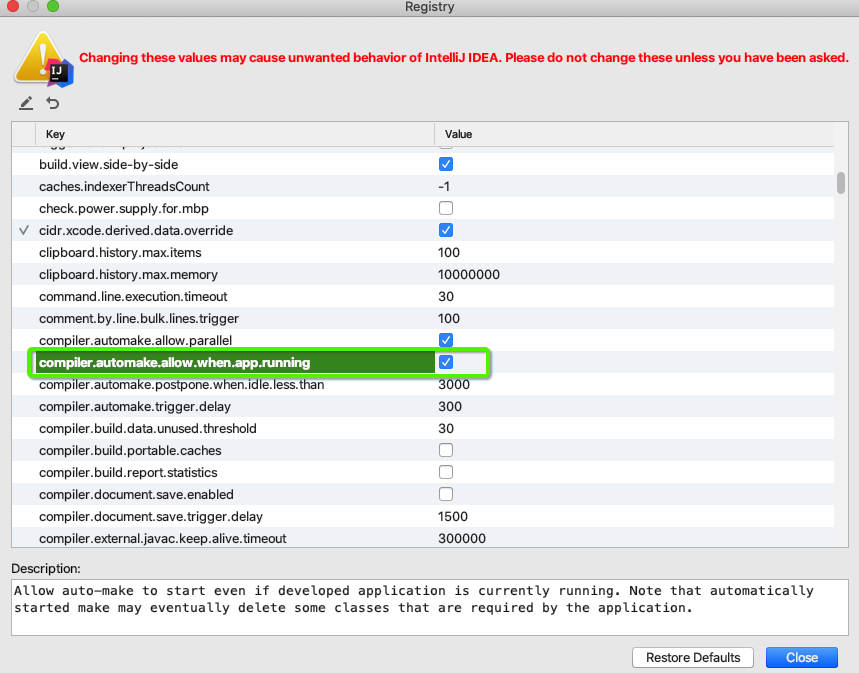学于黑马和传智播客联合做的教学项目 感谢
黑马官网
传智播客官网
微信搜索"艺术行者",关注并回复关键词"springboot"获取视频和教程资料!
b站在线视频
SpringBoot基础
学习目标:
- 能够理解Spring的优缺点
- 能够理解SpringBoot的特点
- 能够理解SpringBoot的核心功能
- 能够搭建SpringBoot的环境
- 能够完成application.properties配置文件的配置
- 能够完成application.yml配置文件的配置
- 能够使用SpringBoot集成Mybatis
- 能够使用SpringBoot集成Junit
- 能够使用SpringBoot集成SpringData JPA
一、SpringBoot简介
1.1 原有Spring优缺点分析
1.1.1 Spring的优点分析
Spring是Java企业版(Java Enterprise Edition,JEE,也称J2EE)的轻量级代替品。无需开发重量级的Enterprise JavaBean(EJB),Spring为企业级Java开发提供了一种相对简单的方法,通过依赖注入和面向切面编程,用简单的Java对象(Plain Old Java Object,POJO)实现了EJB的功能。
1.1.2 Spring的缺点分析
虽然Spring的组件代码是轻量级的,但它的配置却是重量级的。一开始,Spring用XML配置,而且是很多XML配置。Spring 2.5引入了基于注解的组件扫描,这消除了大量针对应用程序自身组件的显式XML配置。Spring 3.0引入了基于注解Java的配置,这是一种类型安全的可重构配置方式,可以代替XML。
所有这些配置都代表了开发时间的损耗。因为在思考Spring特性配置和解决业务问题之间需要进行思维切换,所以编写配置挤占了编写应用程序逻辑的时间。和所有框架一样,Spring实用,但与此同时它要求的回报也不少。
除此之外,项目的依赖管理也是一件耗时耗力的事情。在环境搭建时,需要分析要导入哪些库的坐标,而且还需要分析导入与之有依赖关系的其他库的坐标,一旦选错了依赖的版本,随之而来的不兼容问题就会严重阻碍项目的开发进度。
1.2 SpringBoot的概述
1.2.1 SpringBoot解决上述Spring的缺点
SpringBoot对上述Spring的缺点进行的改善和优化,基于约定优于配置的思想,可以让开发人员不必在配置与逻辑业务之间进行思维的切换,全身心的投入到逻辑业务的代码编写中,从而大大提高了开发的效率,一定程度上缩短了项目周期。
1.2.3 SpringBoot的核心功能
-
起步依赖
起步依赖本质上是一个Maven项目对象模型(Project Object Model,POM),定义了对其他库的传递依赖,这些东西加在一起即支持某项功能。
简单的说,起步依赖就是将具备某种功能的坐标打包到一起,并提供一些默认的功能。
-
自动配置
Spring Boot的自动配置是一个运行时(更准确地说,是应用程序启动时)的过程,考虑了众多因素,才决定Spring配置应该用哪个,不该用哪个。该过程是Spring自动完成的。
二、SpringBoot快速入门
2.1 代码实现
2.1.1 创建Maven工程
使用idea工具创建一个maven工程,该工程为普通的java工程即可
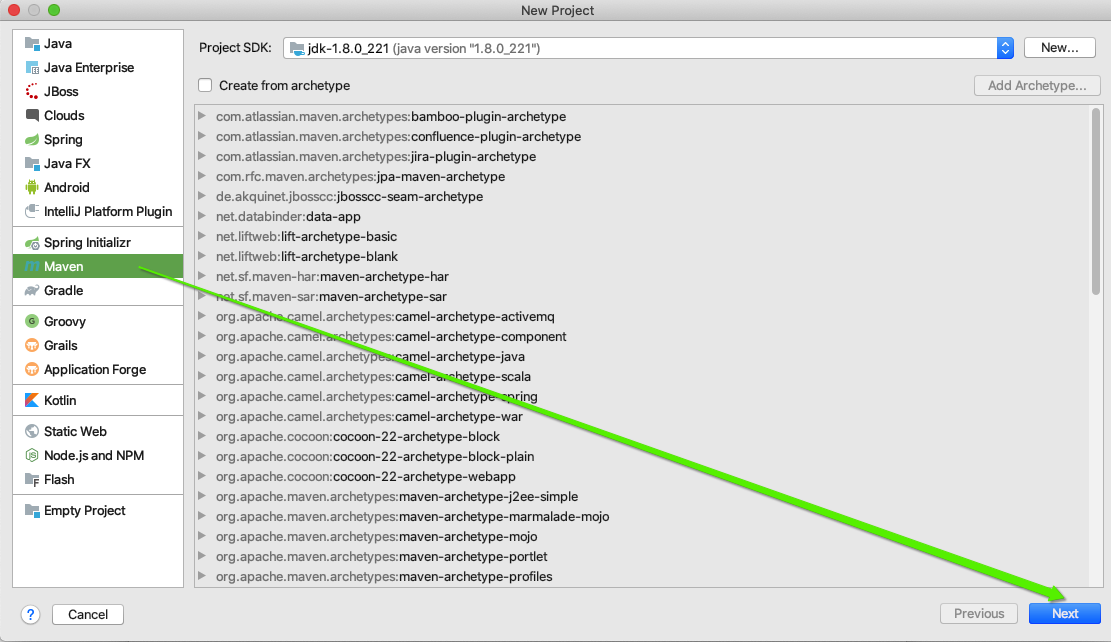
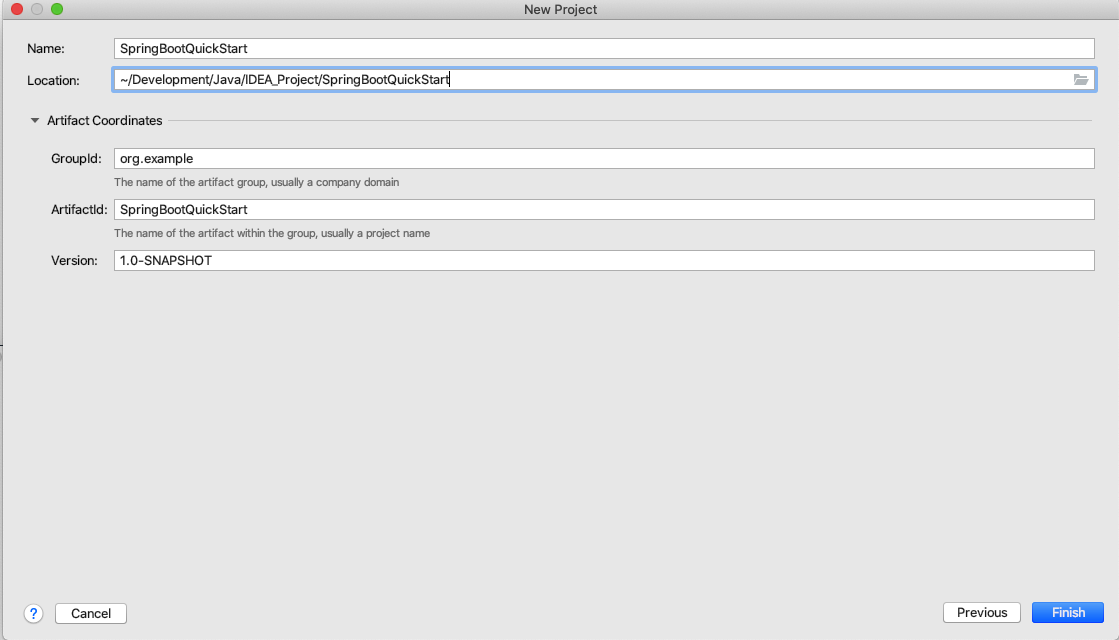
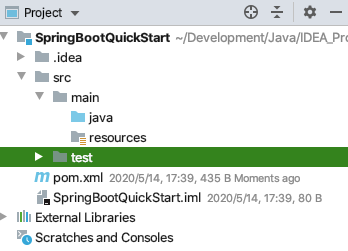
2.1.2 添加SpringBoot的起步依赖
SpringBoot要求,项目要继承SpringBoot的起步依赖spring-boot-starter-parent
<parent>
<groupId>org.springframework.boot</groupId>
<artifactId>spring-boot-starter-parent</artifactId>
<version>2.0.1.RELEASE</version>
</parent>
SpringBoot要集成SpringMVC进行Controller的开发,所以项目要导入web的启动依赖
<dependencies>
<dependency>
<groupId>org.springframework.boot</groupId>
<artifactId>spring-boot-starter-web</artifactId>
</dependency>
</dependencies>
2.1.3 编写SpringBoot引导类
要通过SpringBoot提供的引导类起步SpringBoot才可以进行访问
package org.example;
import org.springframework.boot.SpringApplication;
import org.springframework.boot.autoconfigure.SpringBootApplication;
/**
* @author HackerStar
* @create 2020-05-14 17:44
*/
@SpringBootApplication
public class MySpringBootApplication {
public static void main(String[] args) {
SpringApplication.run(MySpringBootApplication.class);
}
}
2.1.4 编写Controller
在引导类MySpringBootApplication同级包或者子级包中创建QuickStartController
package org.example;
import org.springframework.boot.SpringApplication;
import org.springframework.boot.autoconfigure.SpringBootApplication;
/**
* @author HackerStar
* @create 2020-05-14 17:44
*/
@SpringBootApplication
public class MySpringBootApplication {
public static void main(String[] args) {
SpringApplication.run(MySpringBootApplication.class);
}
}
2.1.5 测试
执行SpringBoot起步类的主方法,控制台打印日志部分如下:
. ____ _ __ _ _
/\\ / ___'_ __ _ _(_)_ __ __ _ \ \ \ \
( ( )\___ | '_ | '_| | '_ \/ _` | \ \ \ \
\\/ ___)| |_)| | | | | || (_| | ) ) ) )
' |____| .__|_| |_|_| |_\__, | / / / /
=========|_|==============|___/=/_/_/_/
:: Spring Boot :: (v2.0.1.RELEASE)
通过日志发现,Tomcat started on port(s): 8080 (http) with context path ''
tomcat已经起步,端口监听8080,web应用的虚拟工程名称为空
打开浏览器访问url地址为:http://localhost:8080/quick

2.2 快速入门解析
2.2.2 SpringBoot代码解析
- @SpringBootApplication:标注SpringBoot的启动类,该注解具备多种功能(后面详细剖析)
- SpringApplication.run(MySpringBootApplication.class) 代表运行SpringBoot的启动类,参数为SpringBoot启动类的字节码对象
2.2.3 SpringBoot工程热部署
我们在开发中反复修改类、页面等资源,每次修改后都是需要重新启动才生效,这样每次启动都很麻烦,浪费了大量的时间,我们可以在修改代码后不重启就能生效,在 pom.xml 中添加如下配置就可以实现这样的功能,我们称之为热部署。
<!--热部署配置-->
<dependency>
<groupId>org.springframework.boot</groupId>
<artifactId>spring-boot-devtools</artifactId>
</dependency>
注意:IDEA进行SpringBoot热部署失败原因
出现这种情况,并不是热部署配置问题,其根本原因是因为Intellij IEDA默认情况下不会自动编译,需要对IDEA进行自动编译的设置,如下:
然后 Shift+command+Alt+/,选择Registry
2.2.4 使用idea快速创建SpringBoot项目

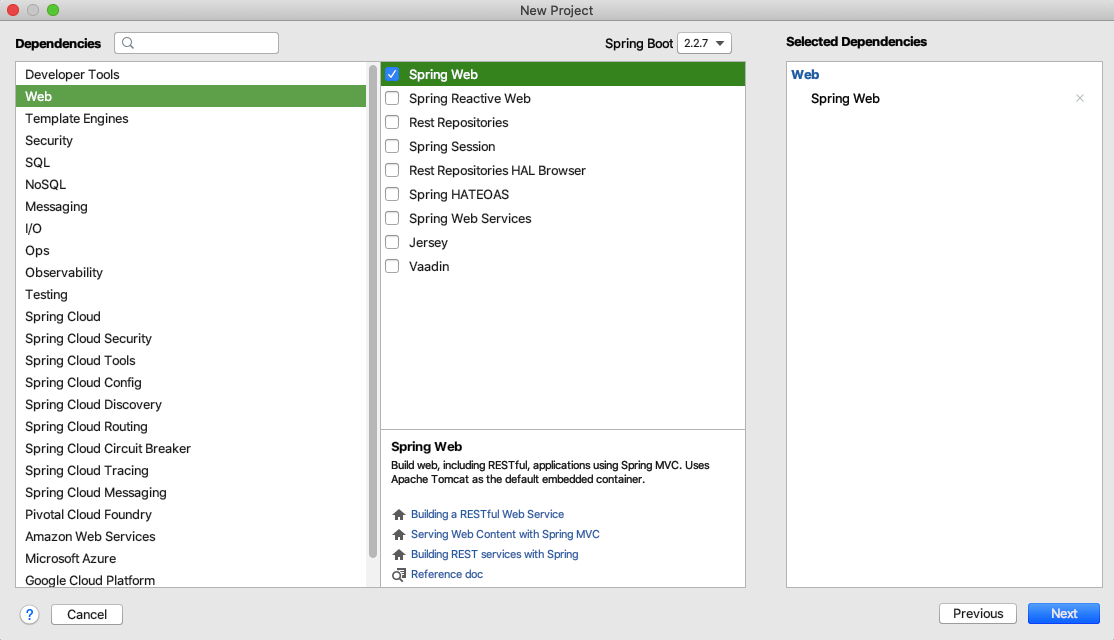
填写项目,指定存放地址,之后点击finish

通过idea快速创建的SpringBoot项目的pom.xml中已经导入了我们选择的web的起步依赖的坐标
修改org.springframework.boot的版本为2.0.1
<?xml version="1.0" encoding="UTF-8"?>
<project xmlns="http://maven.apache.org/POM/4.0.0" xmlns:xsi="http://www.w3.org/2001/XMLSchema-instance"
xsi:schemaLocation="http://maven.apache.org/POM/4.0.0 https://maven.apache.org/xsd/maven-4.0.0.xsd">
<modelVersion>4.0.0</modelVersion>
<parent>
<groupId>org.springframework.boot</groupId>
<artifactId>spring-boot-starter-parent</artifactId>
<version>2.0.1.RELEASE</version>
<relativePath/> <!-- lookup parent from repository -->
</parent>
<groupId>org.example</groupId>
<artifactId>springbootquickstart2</artifactId>
<version>0.0.1-SNAPSHOT</version>
<name>springbootquickstart2</name>
<description>Demo project for Spring Boot</description>
<properties>
<java.version>1.8</java.version>
</properties>
<dependencies>
<dependency>
<groupId>org.springframework.boot</groupId>
<artifactId>spring-boot-starter-web</artifactId>
</dependency>
<dependency>
<groupId>org.springframework.boot</groupId>
<artifactId>spring-boot-starter-test</artifactId>
<scope>test</scope>
<exclusions>
<exclusion>
<groupId>org.junit.vintage</groupId>
<artifactId>junit-vintage-engine</artifactId>
</exclusion>
</exclusions>
</dependency>
</dependencies>
<build>
<plugins>
<plugin>
<groupId>org.springframework.boot</groupId>
<artifactId>spring-boot-maven-plugin</artifactId>
</plugin>
</plugins>
</build>
</project>
可以使用快速入门的方式创建Controller进行访问,此处不再赘述
三、SpringBoot的配置文件
3.1 SpringBoot配置文件类型
3.1.1 SpringBoot配置文件类型和作用
SpringBoot是基于约定的,所以很多配置都有默认值,但如果想使用自己的配置替换默认配置的话,就可以使用application.properties或者application.yml(application.yaml)进行配置。
SpringBoot默认会从Resources目录下加载application.properties或application.yml(application.yaml)文件
其中,application.properties文件是键值对类型的文件,之前一直在使用,所以此处不在对properties文件的格式进行阐述。除了properties文件外,SpringBoot还可以使用yml文件进行配置,下面对yml文件进行讲解。
3.1.2 application.yml配置文件
3.1.2.1 yml配置文件简介
YML文件格式是YAML (YAML Aint Markup Language)编写的文件格式,YAML是一种直观的能够被电脑识别的的数据数据序列化格式,并且容易被人类阅读,容易和脚本语言交互的,可以被支持YAML库的不同的编程语言程序导入,比如: C/C++, Ruby, Python, Java, Perl, C#, PHP等。YML文件是以数据为核心的,比传统的xml方式更加简洁。
YML文件的扩展名可以使用.yml或者.yaml。
3.1.2.2 yml配置文件的语法
3.1.2.2.1 配置普通数据
-
语法: key: value
-
示例代码:
-
name: haohao -
注意:value之前有一个空格
3.1.2.2.2 配置对象数据
-
语法:
key:
key1: value1
key2: value2
或者:
key: {key1: value1,key2: value2}
-
示例代码:
-
person: name: haohao age: 31 addr: beijing #或者 person: {name: haohao,age: 31,addr: beijing} -
注意:key1前面的空格个数不限定,在yml语法中,相同缩进代表同一个级别
3.1.2.2.2 配置Map数据
同上面的对象写法
3.1.2.2.3 配置数组(List、Set)数据
-
语法:
key:
- value1
- value2
或者:
key: [value1,value2]
-
示例代码:
-
city: - beijing - tianjin - shanghai - chongqing #或者 city: [beijing,tianjin,shanghai,chongqing] #集合中的元素是对象形式 student: - name: zhangsan age: 18 score: 100 - name: lisi age: 28 score: 88 - name: wangwu age: 38 score: 90 -
注意:value1与之间的 - 之间存在一个空格
3.1.3 SpringBoot配置信息的查询
上面提及过,SpringBoot的配置文件,主要的目的就是对配置信息进行修改的,但在配置时的key从哪里去查询呢?我们可以查阅SpringBoot的官方文档
常用的配置摘抄如下:
# QUARTZ SCHEDULER (QuartzProperties)
spring.quartz.jdbc.initialize-schema=embedded # Database schema initialization mode.
spring.quartz.jdbc.schema=classpath:org/quartz/impl/jdbcjobstore/tables_@@platform@@.sql # Path to the SQL file to use to initialize the database schema.
spring.quartz.job-store-type=memory # Quartz job store type.
spring.quartz.properties.*= # Additional Quartz Scheduler properties.
# ----------------------------------------
# WEB PROPERTIES
# ----------------------------------------
# EMBEDDED SERVER CONFIGURATION (ServerProperties)
server.port=8080 # Server HTTP port.
server.servlet.context-path= # Context path of the application.
server.servlet.path=/ # Path of the main dispatcher servlet.
# HTTP encoding (HttpEncodingProperties)
spring.http.encoding.charset=UTF-8 # Charset of HTTP requests and responses. Added to the "Content-Type" header if not set explicitly.
# JACKSON (JacksonProperties)
spring.jackson.date-format= # Date format string or a fully-qualified date format class name. For instance, `yyyy-MM-dd HH:mm:ss`.
# SPRING MVC (WebMvcProperties)
spring.mvc.servlet.load-on-startup=-1 # Load on startup priority of the dispatcher servlet.
spring.mvc.static-path-pattern=/** # Path pattern used for static resources.
spring.mvc.view.prefix= # Spring MVC view prefix.
spring.mvc.view.suffix= # Spring MVC view suffix.
# DATASOURCE (DataSourceAutoConfiguration & DataSourceProperties)
spring.datasource.driver-class-name= # Fully qualified name of the JDBC driver. Auto-detected based on the URL by default.
spring.datasource.password= # Login password of the database.
spring.datasource.url= # JDBC URL of the database.
spring.datasource.username= # Login username of the database.
# JEST (Elasticsearch HTTP client) (JestProperties)
spring.elasticsearch.jest.password= # Login password.
spring.elasticsearch.jest.proxy.host= # Proxy host the HTTP client should use.
spring.elasticsearch.jest.proxy.port= # Proxy port the HTTP client should use.
spring.elasticsearch.jest.read-timeout=3s # Read timeout.
spring.elasticsearch.jest.username= # Login username.
我们可以通过配置application.poperties 或者 application.yml 来修改SpringBoot的默认配置
例如:
application.properties文件
server.port=8888
server.servlet.context-path=demo
application.yml文件
server:
port: 8888
servlet:
context-path: /demo
3.2 配置文件与配置类的属性映射方式
3.2.1 使用注解@Value映射
我们可以通过@Value注解将配置文件中的值映射到一个Spring管理的Bean的字段上
例如:
application.properties配置如下:
person:
name: zhangsan
age: 18
或者,application.yml配置如下:
person:
name: zhangsan
age: 18
实体Bean代码如下:
package org.example.controller;
import org.springframework.beans.factory.annotation.Value;
import org.springframework.stereotype.Controller;
import org.springframework.web.bind.annotation.RequestMapping;
import org.springframework.web.bind.annotation.ResponseBody;
/**
* @author HackerStar
* @create 2020-05-14 20:42
*/
@Controller
public class QucikStart2Controller {
@Value("${person.name}")
private String name;
@Value("${person.age}")
private Integer age;
@RequestMapping("/quick2")
@ResponseBody
public String quick2() {
return "name:" + name + "," + "age:" + age;
}
@RequestMapping("/quick1")
@ResponseBody
public String quick() {
return "quick start 2";
}
}
结果如下:

3.2.2 使用注解@ConfigurationProperties映射
通过注解@ConfigurationProperties(prefix="配置文件中的key的前缀")可以将配置文件中的配置自动与实体进行映射
application.properties配置如下:
person:
name: zhangsan
age: 18
或者,application.yml配置如下:
person:
name: zhangsan
age: 18
实体Bean代码如下:
package org.example.controller;
import org.springframework.beans.factory.annotation.Value;
import org.springframework.boot.context.properties.ConfigurationProperties;
import org.springframework.context.annotation.Configuration;
import org.springframework.stereotype.Controller;
import org.springframework.web.bind.annotation.RequestMapping;
import org.springframework.web.bind.annotation.ResponseBody;
/**
* @author HackerStar
* @create 2020-05-14 20:42
*/
@Controller
@ConfigurationProperties(prefix = "person")
public class QucikStart2Controller {
private String name;
private Integer age;
@RequestMapping("/quick2")
@ResponseBody
public String quick2() {
return "name:" + name + "," + "age:" + age;
}
public void setName(String name) {
this.name = name;
}
public void setAge(Integer age) {
this.age = age;
}
}
注意设置属性的set方法
结果如下:

注意:使用@ConfigurationProperties方式可以进行配置文件与实体字段的自动映射,但需要字段必须提供set方法才可以,而使用@Value注解修饰的字段不需要提供set方法
四、SpringBoot与整合其他技术
4.1 SpringBoot整合Mybatis
4.1.1 添加Mybatis的起步依赖
<!--mybatis起步依赖-->
<dependency>
<groupId>org.mybatis.spring.boot</groupId>
<artifactId>mybatis-spring-boot-starter</artifactId>
<version>1.1.1</version>
</dependency>
4.1.2 添加数据库驱动坐标
<!-- MySQL连接驱动 -->
<dependency>
<groupId>mysql</groupId>
<artifactId>mysql-connector-java</artifactId>
</dependency>
4.1.3 添加数据库连接信息
#DB Configuration:
spring.datasource.driverClassName=com.mysql.jdbc.Driver
spring.datasource.url=jdbc:mysql://127.0.0.1:3306/test?useUnicode=true&characterEncoding=utf8
spring.datasource.username=root
spring.datasource.password=root
4.1.4 创建user表
-- ----------------------------
-- Table structure for `user`
-- ----------------------------
DROP TABLE IF EXISTS `user`;
CREATE TABLE `user` (
`id` int(11) NOT NULL AUTO_INCREMENT,
`username` varchar(50) DEFAULT NULL,
`password` varchar(50) DEFAULT NULL,
`name` varchar(50) DEFAULT NULL,
PRIMARY KEY (`id`)
) ENGINE=InnoDB AUTO_INCREMENT=10 DEFAULT CHARSET=utf8;
-- ----------------------------
-- Records of user
-- ----------------------------
INSERT INTO `user` VALUES ('1', 'zhangsan', '123', '张三');
INSERT INTO `user` VALUES ('2', 'lisi', '123', '李四');
4.1.5 创建实体Bean
package org.example.domain;
/**
* @author HackerStar
* @create 2020-05-14 21:13
*/
public class User {
//主键
private Long id;
//用户名
private String username;
//密码
private String password;
//姓名
private String name;
@Override
public String toString() {
return "User{" +
"id=" + id +
", username='" + username + '\'' +
", password='" + password + '\'' +
", name='" + name + '\'' +
'}';
}
public Long getId() {
return id;
}
public void setId(Long id) {
this.id = id;
}
public String getUsername() {
return username;
}
public void setUsername(String username) {
this.username = username;
}
public String getPassword() {
return password;
}
public void setPassword(String password) {
this.password = password;
}
public String getName() {
return name;
}
public void setName(String name) {
this.name = name;
}
}
4.1.6 编写Mapper
package org.example.dao;
import org.apache.ibatis.annotations.Mapper;
import org.example.domain.User;
import java.util.List;
/**
* @author HackerStar
* @create 2020-05-14 21:15
*/
@Mapper
public interface UserDao {
public List<User> queryUserList();
}
注意:@Mapper标记该类是一个mybatis的mapper接口,可以被spring boot自动扫描到spring上下文中
4.1.7 配置Mapper映射文件
在src\main\resources\dao路径下加入UserDao.xml配置文件"
<?xml version="1.0" encoding="utf-8" ?>
<!DOCTYPE mapper PUBLIC "-//mybatis.org//DTD Mapper 3.0//EN" "http://mybatis.org/dtd/mybatis-3-mapper.dtd" >
<mapper namespace="com.itheima.mapper.UserMapper">
<select id="queryUserList" resultType="user">
select * from user
</select>
</mapper>
4.1.8 在application.properties中添加mybatis的信息
#spring集成Mybatis环境
#pojo别名扫描包
mybatis.type-aliases-package=com.itheima.domain
#加载Mybatis映射文件
mybatis.mapper-locations=classpath:mapper/*Mapper.xml
4.1.9 编写测试Controller
package org.example.controller;
import org.example.dao.UserDao;
import org.example.domain.User;
import org.springframework.beans.factory.annotation.Autowired;
import org.springframework.stereotype.Controller;
import org.springframework.web.bind.annotation.RequestMapping;
import org.springframework.web.bind.annotation.ResponseBody;
import java.util.List;
/**
* @author HackerStar
* @create 2020-05-14 21:19
*/
@Controller
public class DaoController {
@Autowired
private UserDao userDao;
@RequestMapping("/queryUser")
@ResponseBody
public List<User> queryUser() {
List<User> users = userDao.queryUserList();
return users;
}
}
4.1.10 测试

4.2 SpringBoot整合Junit
4.2.1 添加Junit的起步依赖
<!--测试的起步依赖-->
<dependency>
<groupId>org.springframework.boot</groupId>
<artifactId>spring-boot-starter-test</artifactId>
<scope>test</scope>
</dependency>
4.2.2 编写测试类
package org.example;
import org.example.dao.UserDao;
import org.example.domain.User;
import org.junit.Test;
import org.junit.runner.RunWith;
import org.springframework.beans.factory.annotation.Autowired;
import org.springframework.boot.test.context.SpringBootTest;
import org.springframework.test.context.junit4.SpringRunner;
import java.util.List;
/**
* @author HackerStar
* @create 2020-05-14 21:30
*/
@RunWith(SpringRunner.class)
@SpringBootTest(classes = Stringbootquickstart3Application.class)
public class DaoTest {
@Autowired
private UserDao userDao;
@Test
public void test() {
userDao.queryUserList().forEach(user -> System.out.println(user));
}
}
其中,
SpringRunner继承自SpringJUnit4ClassRunner,使用哪一个Spring提供的测试测试引擎都可以
public final class SpringRunner extends SpringJUnit4ClassRunner
@SpringBootTest的属性指定的是引导类的字节码对象
4.2.3 控制台打印信息

4.3 SpringBoot整合Spring Data JPA
5.3.1 添加Spring Data JPA的起步依赖
<!-- springBoot JPA的起步依赖 -->
<dependency>
<groupId>org.springframework.boot</groupId>
<artifactId>spring-boot-starter-data-jpa</artifactId>
</dependency>
5.3.2 添加数据库驱动依赖
<!-- MySQL连接驱动 -->
<dependency>
<groupId>mysql</groupId>
<artifactId>mysql-connector-java</artifactId>
</dependency>
5.3.3 在application.properties中配置数据库和jpa的相关属性
#DB Configuration:
spring.datasource.driverClassName=com.mysql.jdbc.Driver
spring.datasource.url=jdbc:mysql://127.0.0.1:3306/test?useUnicode=true&characterEncoding=utf8
spring.datasource.username=root
spring.datasource.password=root
#JPA Configuration:
spring.jpa.database=MySQL
spring.jpa.show-sql=true
spring.jpa.generate-ddl=true
spring.jpa.hibernate.ddl-auto=update
spring.jpa.hibernate.naming_strategy=org.hibernate.cfg.ImprovedNamingStrategy
5.3.4 创建实体配置实体
package org.example.domain;
import javax.persistence.Entity;
import javax.persistence.GeneratedValue;
import javax.persistence.GenerationType;
import javax.persistence.Id;
/**
* @author HackerStar
* @create 2020-05-14 21:13
*/
@Entity
public class User {
@Id
@GeneratedValue(strategy = GenerationType.IDENTITY)
//主键
private Long id;
//用户名
private String username;
//密码
private String password;
//姓名
private String name;
@Override
public String toString() {
return "User{" +
"id=" + id +
", username='" + username + '\'' +
", password='" + password + '\'' +
", name='" + name + '\'' +
'}';
}
public Long getId() {
return id;
}
public void setId(Long id) {
this.id = id;
}
public String getUsername() {
return username;
}
public void setUsername(String username) {
this.username = username;
}
public String getPassword() {
return password;
}
public void setPassword(String password) {
this.password = password;
}
public String getName() {
return name;
}
public void setName(String name) {
this.name = name;
}
}
5.3.5 编写UserRepository
package org.example.Repository;
import org.example.domain.User;
import org.springframework.data.jpa.repository.JpaRepository;
import java.util.List;
/**
* @author HackerStar
* @create 2020-05-14 22:00
*/
public interface UserRepository extends JpaRepository<User,Long> {
public List<User> findAll();
}
5.3.6 编写测试类
package org.example;
import org.example.Repository.UserRepository;
import org.example.domain.User;
import org.junit.Test;
import org.junit.runner.RunWith;
import org.springframework.beans.factory.annotation.Autowired;
import org.springframework.boot.test.context.SpringBootTest;
import org.springframework.test.context.junit4.SpringRunner;
import java.util.List;
/**
* @author HackerStar
* @create 2020-05-14 22:01
*/
@RunWith(SpringRunner.class)
@SpringBootTest(classes = Stringbootquickstart3Application.class)
public class JpaTest {
@Autowired
private UserRepository userRepository;
@Test
public void test() {
userRepository.findAll().forEach(user -> System.out.println(user));
}
}
5.3.7 控制台打印信息

注意:如果是jdk9,执行报错如下:

解决方案:手动导入对应的maven坐标,如下:
<!--jdk9需要导入如下坐标-->
<dependency>
<groupId>javax.xml.bind</groupId>
<artifactId>jaxb-api</artifactId>
<version>2.3.0</version>
</dependency>
4.4 SpringBoot整合Redis
4.4.1 添加redis的起步依赖
<!-- 配置使用redis启动器 -->
<dependency>
<groupId>org.springframework.boot</groupId>
<artifactId>spring-boot-starter-data-redis</artifactId>
</dependency>
4.4.2 配置redis的连接信息
#Redis
spring.redis.host=127.0.0.1
spring.redis.port=6379
4.4.3 注入RedisTemplate测试redis操作
package org.example;
import com.fasterxml.jackson.core.JsonProcessingException;
import com.fasterxml.jackson.databind.ObjectMapper;
import org.example.Repository.UserRepository;
import org.example.domain.User;
import org.junit.Test;
import org.junit.runner.RunWith;
import org.springframework.beans.factory.annotation.Autowired;
import org.springframework.boot.test.context.SpringBootTest;
import org.springframework.data.redis.core.RedisTemplate;
import org.springframework.test.context.junit4.SpringRunner;
import java.util.List;
/**
* @author HackerStar
* @create 2020-05-14 22:07
*/
@RunWith(SpringRunner.class)
@SpringBootTest(classes = Stringbootquickstart3Application.class)
public class RedisTest {
@Autowired
private UserRepository userRepository;
@Autowired
private RedisTemplate<String, String> redisTemplate;
@Test
public void test() throws Exception {
//从redis缓存中获得指定的数据
String userListData = redisTemplate.boundValueOps("user.findAll").get();
//如果redis中没有数据的话
if(userListData == null) {
//查询数据库获得数据
List<User> all = userRepository.findAll();
//转换成json格式字符串
ObjectMapper objectMapper = new ObjectMapper();
userListData = objectMapper.writeValueAsString(all);
//将数据存储到redis中,下次再查询从redis中获得数据,不用再查询数据库
redisTemplate.boundValueOps("user.findAll").set(userListData);
System.out.println("---------------------从数据库获得数据---------------------");
} else {
System.out.println("---------------------从redis缓存中获得数据---------------------");
}
System.out.println(userListData);
}
}

